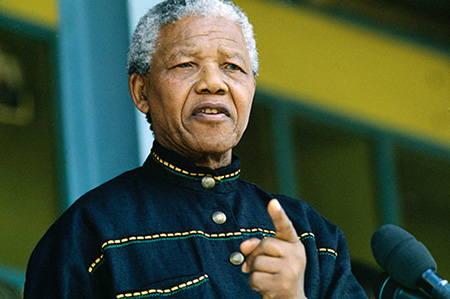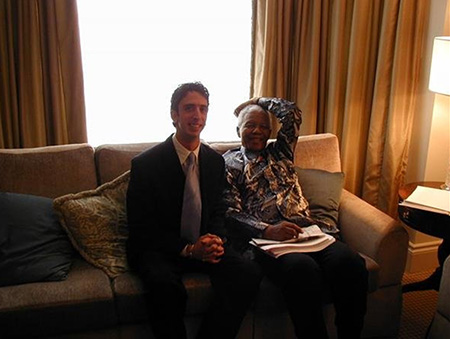
Former South African President Nelson Mandela died on December 5, 2013. Photo by Greg Marinovich
As the world grapples with the death of Nelson Mandela, journalists are reflecting on the man and his legacy. Some of those who covered him the longest and knew him the best are Nieman Fellows from South Africa.
Fleur de Villiers, NF ’81, relishes her close encounters with what’s been called “Madiba magic.” She writes, “And like everyone who saw and heard him I fell a willing victim to his charm, his infectious good humor, and his love of life.”
Pippa Green, NF ’99, covered Mandela’s presidency extensively for the public broadcaster and a Sunday newspaper in South Africa. What has stayed with her are the simple acts of kindness that exemplified his leadership style.
At the time of Mandela’s release from prison, Richard Steyn, NF ’86, was editor in chief of The Star in Johannesburg. It was in 1992 that Mandela reached out to President de Klerk, in an interview with The Star, to “save the country from disaster.”
In an audio slideshow, South African photojournalist Greg Marinovich, NF ’14, looks back on his life and career in Mandela’s shadow. His photography chronicles the long violent nightmare of apartheid. Marinovich first knew Mandela as the man next door who was kind enough to bring milk to his grandmother.
Allister Sparks, NF ’63, former editor of the Rand Daily Mail, describes meeting Mandela shortly after he was released from prison. He also writes about a moving visit Mandela paid to Sparks’s wife as she neared death. Mandela, then president of South Africa, was on his way to Saudi Arabia but he made the time to stop at the Sparks home.
John Ryan, NF ’70, recalls Mandela’s sentencing in 1964 and his release from prison in 1990. In his first encounter with Mandela, Ryan was a young reporter in the courtroom press gallery. Twenty-six years later Ryan reported for The Argus Africa News Service on Mandela’s first trip outside of South Africa since his imprisonment.
Nadia Tromp, ’13 Nieman affiliate, took her three children to Mandela’s residence, not far from her own home in Johannesburg, so they could pay tribute to the man who taught the world about the power of forgiveness.

David Skok, NF ’12, met Nelson Mandela while studying at Ryerson University in 2001. Photo courtesy of David Skok
David Skok, NF ’12, whose family emigrated from South Africa to Canada, writes, “Many people have asked me through the years, how could you grow up in apartheid South Africa without knowing about Mandela? The sad truth I still wrestle with today – is that it was very easy to not know what was going on.”
This summer Janet Heard, NF ’10, published an open letter to Mandela on his 95th birthday.
In every class of Nieman Fellows since 1961, there has been at least one South African journalist. For some South African journalists, such as Tony Heard, NF ’88, the Nieman year offered a safe haven. Heard, editor of South Africa’s Cape Times, was arrested in 1987 over an illegal interview with African National Congress leader Oliver Tambo.
In a commentary on GlobalPost, former Nieman curator Bob Giles described meeting Mandela in 1993, three years after he had been freed from prison. Mandela demonstrated no bitterness about his long ordeal. He asked, “What’s the point of being angry?”
Earlier this year, South African press ombudsman Joseph Thloloe, NF ’89, discussed the challenges that journalists in the country faced under apartheid and how conditions improved after Mandela’s election.

